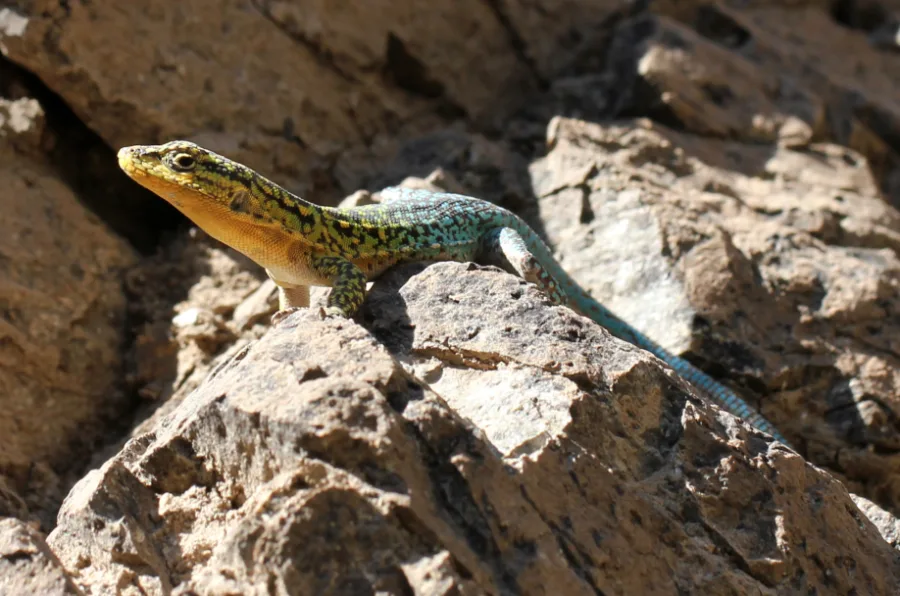
About the cool lives of frozen lizards
Lizards are leaders in telling the story of survival of the most adaptive.
Elsa, you're not the only one with awesome frozen powers. There's a genus of lizards called Liolaemus who can supercool their bodies to survive in extreme environments.
Liolaemus is the second-largest genus among all mammals, birds and reptiles, out-genus-ed by another type of lizard, called anoles. In a millennia game of the survival of the fittest, these genera have adapted into hundreds of species with, colloquially put, super-cool traits.
CRYOBIOLOGY
Cryobiology is essentially how animals deal with extreme cold. If you're a fictional princess, you may sing a song, if you're human, you may layer-up, if you're a Liolaemus, you may freeze your body for the night.
Dr. Stephan Halloy first discovered this unique party trick in the 1970s when he was exploring mountains in San Miguel de Tucumán, Argentina.
Dr. Halloy was collecting data on plants and wildlife when he discovered lizards hanging out at elevations of 13,000 to 16,400 feet. Considering these areas are hot during the day and freezing at night, he was surprised to see lizards.
Halloy collected some lizards, put them in a box by his tent, and called it a night. In the morning, Dr. Halloy awoke to greet his newfound friends. He opened the box, and they were frozen rock-solid. But as the sun rose, so did their body temperatures. And soon they were back to running around like their lizard-selves.
HOW THEY KEEP THEIR COOL
In the 1990s, Robert Espinoza, a biologist at California State University, Northridge, heard about Dr. Halloy's story and has been studying lizards ever since.
We reached out to Dr. Espinoza to find out more about frozen lizards and his interest in lizards of all temperatures. He says that he's "always been fascinated with many aspects of their lives: diversity in colors, body shapes, and adaptability to new and varied environments, behavior, physiology, morphology, reproductive strategies, etc."
One of those reproductive strategies is the way lizards give birth. In Canada, for example, there are only six species of lizards (due to our high-latitude and correlated extended winters). Lizards are ectotherms, meaning they get their heat from external sources.
So some brilliant Canadian lizards have adapted to give birth to live young, instead of an egg. Dr. Espinoza further explains that "Lizards that give birth to live young retain the developing embryos inside themselves where the moms can select the proper temperature in the environment for embryo development."
Espinoza continues to explain that "They do this by shuttling between sunny and shady spots, which raises and lowers their body temperature (and that of their embryos). In doing so, they can select the best temperature for offspring development, which is not possible for species that leave their eggs in soil nests."
Aside from reproductive cooling activity, lizards have three techniques to endure the day-to-day, and day-to-night, extreme temperatures. Lizards either go underground, stay still and drop their body temperatures, or employ short-term full-body freezing.
A HUMAN APPLICATION FOR CRYOBIOLOGY
Through experimentation, Dr. Espinoza and his team have determined that lizards can live at an altitude of 13,369 feet and survive temperatures as cold as -11.56 Celcius. Dr. Halloy initially encountered lizards at 1,640 feet higher than that, which presumably has even lower temperatures.
Dr. Espinoza's decades of studies focus on the "how" of animal function. Self-freezing is definitely an interesting "how" of the preservation function.
So when asked if studying animals' freezing mechanisms has led to any human applications, Dr. Espinoza recalls that "early research in cryobiology has led to better ways of preserving human donor organs (hearts, kidneys, etc.) during transport so they are viable longer prior to implanting into the recipient patient."
"Study lizards" seems like a response from a six-year-old when asked, "what do you want to do when you're older?" So, when someone who is living a dream-career is asked what he would do if there were absolutely no contstraints on anthing, Dr. Espinoza responded "I would set my time machine back to the time of giant reptiles, the dinosaurs (Mesozoic Era, ~250–65 mya)." Cool.